Social Networking: Evolution, Sales, and Acceptance
Communication of people at a distance has transformed over time. Messengers with oral messages, messengers with dispatches, optical telegraphs on towers, information transmission systems using light signals, telegraphs, telephones, mobile communications, the Internet - this is an ongoing process necessary to satisfy the natural needs of a social being in communication.
Social networks have become the most important tools at the moment, allowing people to talk to each other, share thoughts, images, videos, broadcasts, and advertisers to make targeted advertising for the target groups they need.
Today we’ll talk about how social networks evolved over the course of our history from 1995 to the present day, why and how it is beneficial for companies to use social networks, and how Vkontakte and Instagram have grown into the lives of ordinary people.
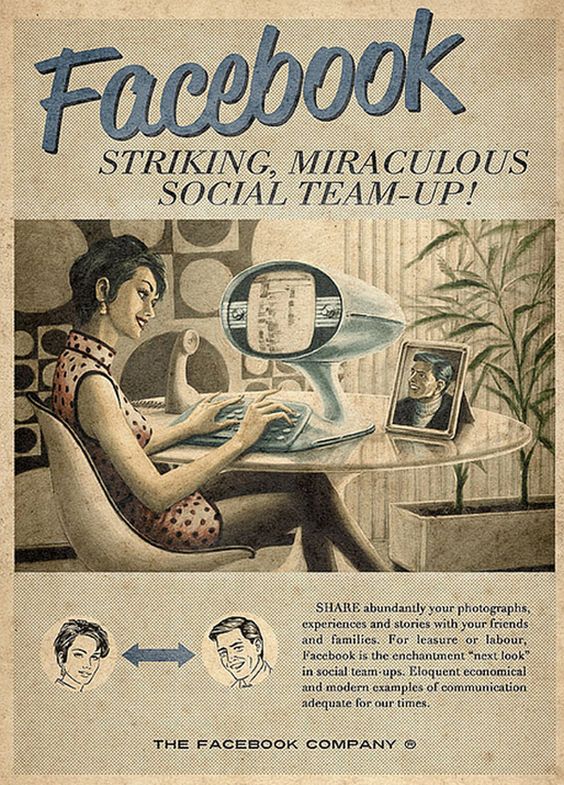
 The emergence of social networks was a matter of time. It was predicted back in the 19th century, when scientists were only trying to invent a working telegraph. Vladimir Odoevsky in the novel "4338 year" described a cross between LiveJournal and Instagram. In his world of the future, correspondence is being maintained between the houses with the help of newspapers. The senior butler, writing down the words from the words hozing at home, photographs it on a pinhole camera and publishes it in the required number of copies. Usually they report home news, various thoughts, invite them to dinner. For faster communication, for emergency cases, there are magnetic telegraphs between the houses.
The emergence of social networks was a matter of time. It was predicted back in the 19th century, when scientists were only trying to invent a working telegraph. Vladimir Odoevsky in the novel "4338 year" described a cross between LiveJournal and Instagram. In his world of the future, correspondence is being maintained between the houses with the help of newspapers. The senior butler, writing down the words from the words hozing at home, photographs it on a pinhole camera and publishes it in the required number of copies. Usually they report home news, various thoughts, invite them to dinner. For faster communication, for emergency cases, there are magnetic telegraphs between the houses.
The author wrote his futuristic work in 1835, when the Russian diplomat and historian Paul Schilling had already assembled an electromagnetic telegraph in St. Petersburg, and Morse had not yet patentedhis version of the telegraph and did not receive a subsidy for the construction of the first line.
The fantasy of man is limitless. Thomas Edison in 1878 described the Telephonoscope, which can transmit images and sound so that relatives who are far apart can communicate. Like Vkontakte or Periscope. But even though fantasy moves forward, it works within the limits of available technologies - they thought then by telegraph, photographs and handwritten texts.
In the 1920s, the idea was implemented in Bell's telephone laboratory: then the research department tested a prototype that transmits audio and video from Washington to the AT&T New York office.
But smartphones in pockets at that moment were not even dreamed of.
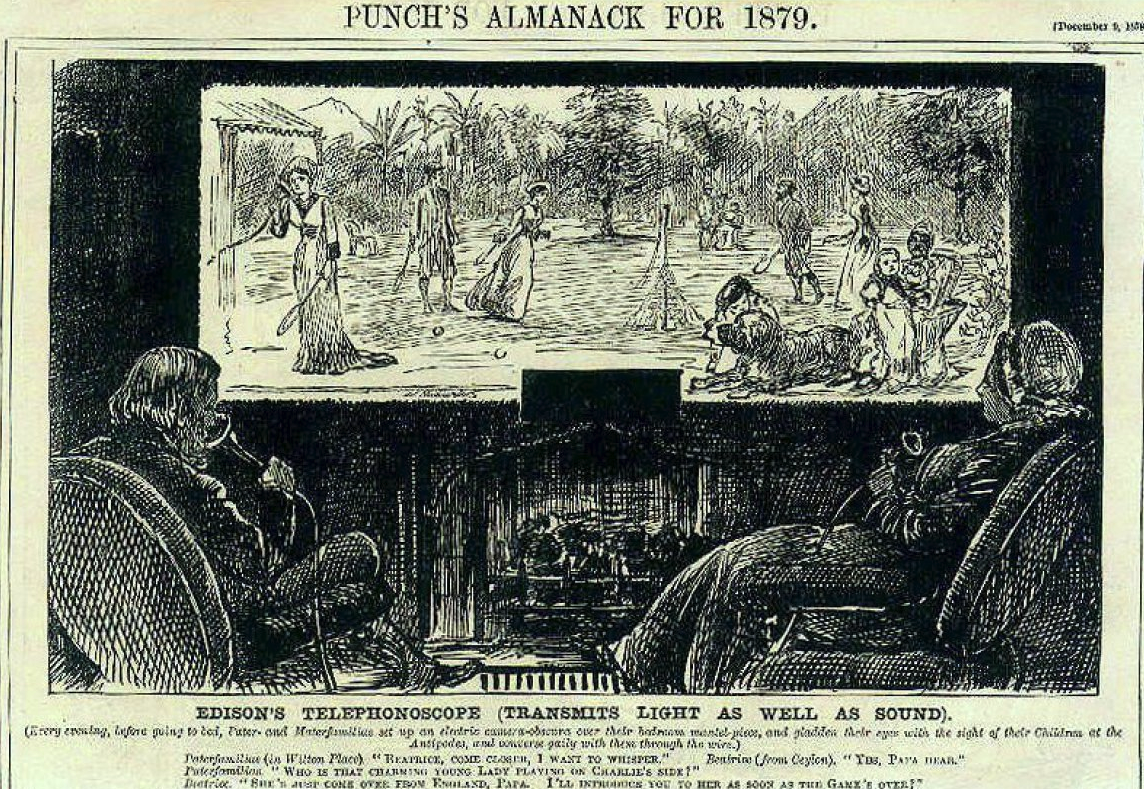
Illustration for Thomas Edison's Idea
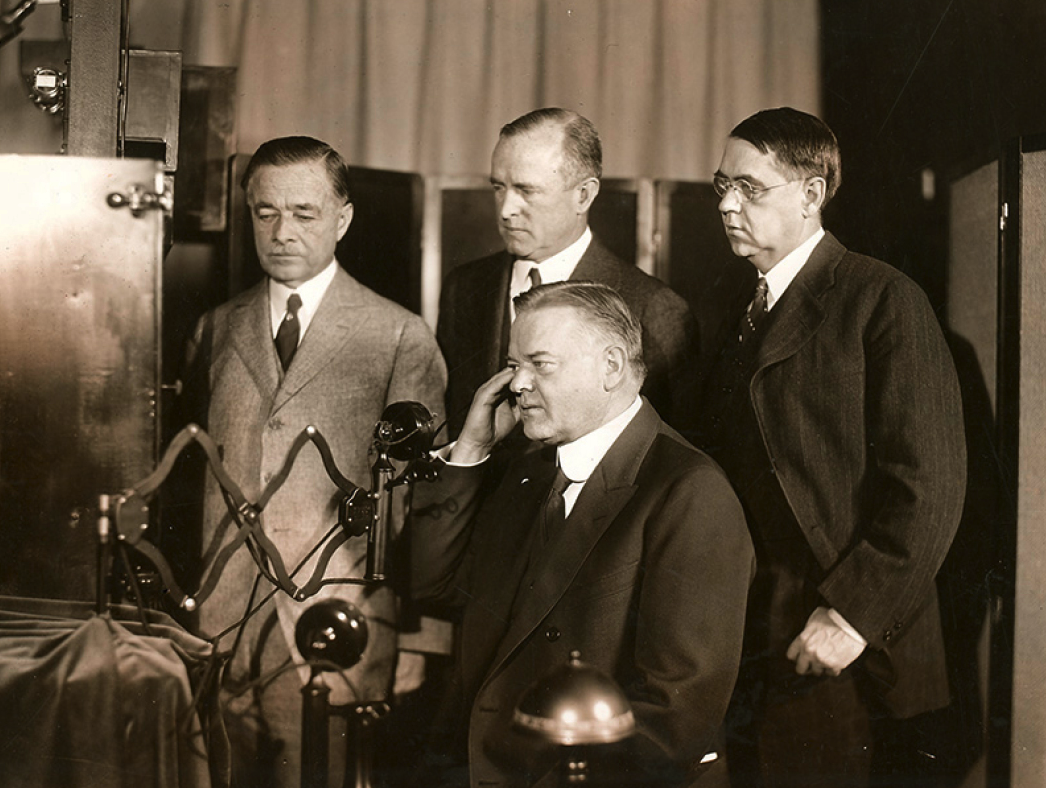
A one-way videophone developed at Bell Lab
on October 29, 1969, was the first to establish a connection between computers at the universities of Los Angeles and Stanford. In 1971, they developed a program for sending emails between computers. The ARPANET network in 1973 became international - it was connected to a transatlantic telephone cable. It allowed the exchange of information between scientific organizations in Europe and the USA. In 1984, scientists created the NSFNet network, which combined many university networks.
The advent of the Internet has opened up new opportunities for quick communication. First for the military, then for scientists, and then for the general public. In 1989, Tim Berners-Lee from CERN proposed the concept of the World Wide Web, developed the HTTP protocol. In 1991, private homes were finally connected to the Internet, not just educational institutions and military structures.
Since 1995, you can begin the history of precisely social networks. The Classmates.com portal, which still exists, was a pioneer. It allows you to find classmates, fellow soldiers, classmates from kindergarten, work colleagues. Over time, developers launched versions of the site with the same design and functionality for other countries.
In 2008, the portal Classmates.comtotaled fifty million subscribers. Of these, 3.8 million paid for membership.
Thanks to a lot of love for email newsletters ( just like Linkedin ), the portal has become a defendant in several legal proceedings. For example, in 2008, he paid users $ 9.5 million.

In 2002, the previously mentioned LinkedIn, a social network for business contacts, entered the scene. Here you could find a colleague in work or in a field of activity, tell about your work successes. In fact, a profile is a ready-made resume. The network allows you to monitor companies that periodically place vacancies.
Microsoft bought this social network in the summer of 2016 for $ 26.2 billion - it gave a little less than a third of its own cash.
The price is due to the fact that the network is actively developing and making a profit. LinkedIn has over two million paid subscribers that you can contact directly. In total, the community has 433 million members.
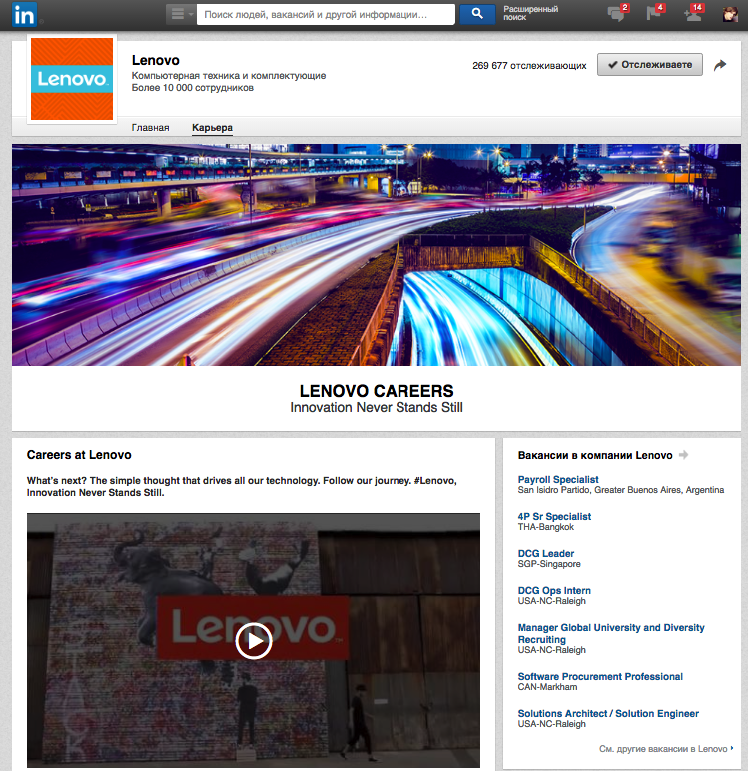
In 2003, the MySpace blogging platform appeared. This site was originally intended for young people who want to read, listen to music, share video content, post their photos and blog. In June 2012, attendance amounted to 25 million people.
For several years, MySpace has been the most popular social network in the world. But in 2008, that changed when Facebook recorded 129 million unique users and MySpace 114.6 million users.
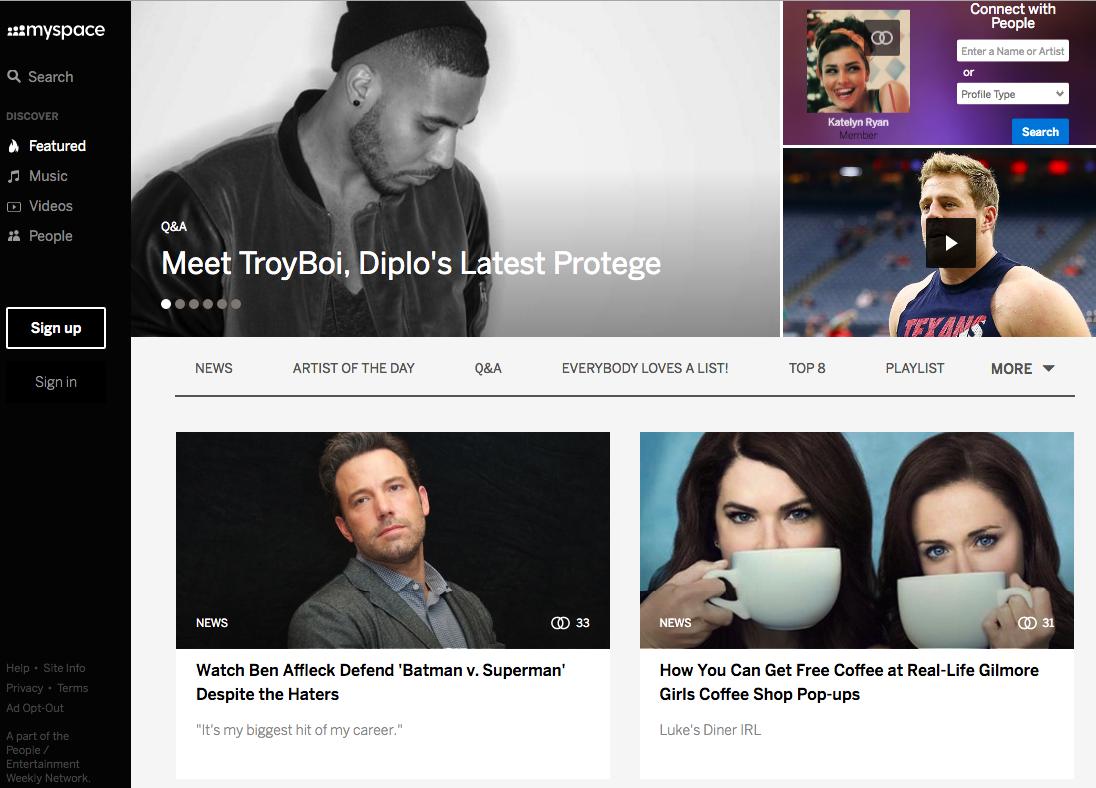
Thefacebook website openedFebruary 4, 2004 and was available only to students at Harvard University. For twelve years, the social network has lost the article and reached 1.71 billion active visitors per month. Mark Zuckerberg became the youngest billionaire of the planet at 23 thanks to his invention.
Initially, the network was intended for students at Harvard University. In 2004, the audience was expanded to Stanford, Columbia University and Yale. In September 2006, the network became open to all users over the age of thirteen.
Facebook allows users to create their own page with photos and information, chat with friends, leave messages on the walls, upload videos and create groups, as well as company pages. Facebook as a tool for influencing the audience is used by many large corporations and local organizations. Actively use this social network businessmen and politicians for reputation purposes.
In April 2016, Facebook Live was launched on the social network - that is, its own Periscope.
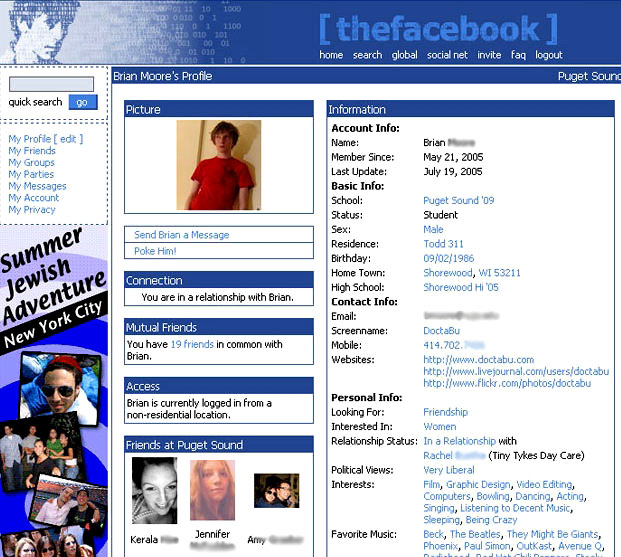
Facebook design in 2004

Mark Zuckerberg's Facebook page in 2006
A similar story with the social network Vkontakte, the most popular in Russia. October 10, 2006 Pavel Durov launched this site as a network for students and graduates.
According to the data on October 2016 in a social network come daily over 80 million users. Of these, 65% are from Russia.
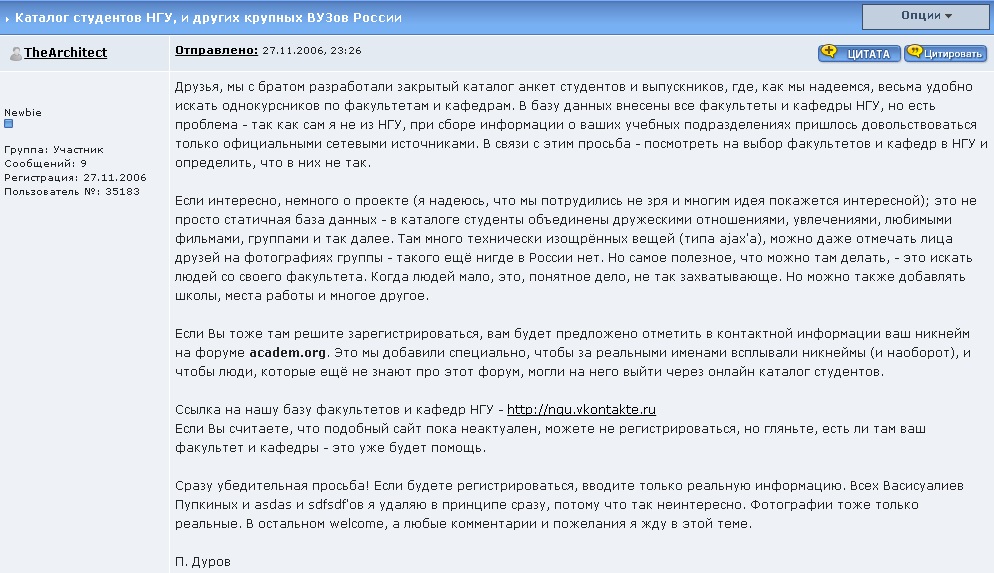
Vkontakte: the beginning

Vkontakte design in 2007
Albert Popkov launched Odnoklassniki on March 26, 2005. Prior to this, Popkov already participated in the creation of similar projects in Europe. In just eight months, the number of registered users reached one and a half million people, in 2007 this figure rose to four million.
In 2008, by analogy with Classmates, a paid subscription was introduced, only this time - not for additional functions, but at the registration stage. The site’s popularity has fallen, users overflowed VKontakte, and in 2010 they canceled paid registration. For 2010, 56% of network users are people aged 25-44.
In 2016, the function of money transfers and streaming broadcasts appeared on the social network, the company released the “OK video” application for Smart TV and integrated with Instagram.

In 2006, Twitter was launched. It was an SMS service for communicating with a small group of people. The question “What are you doing now?” Was central from the start. First tweetappeared on March 21, 2006, Jack Dorsey left him: "just setting up my twttr." Messages on Twitter several years ago could be published from ordinary phones - by sending text to the desired number for posting.
Initially, the number of characters was limited to 140. To fit the link, began to use abbreviations. In 2016, concessions were made - and the service stopped considering links in the restriction .
The whole point of Twitter is to put thought, idea, information for your friends into these 140 characters. Brevity is the soul of wit.
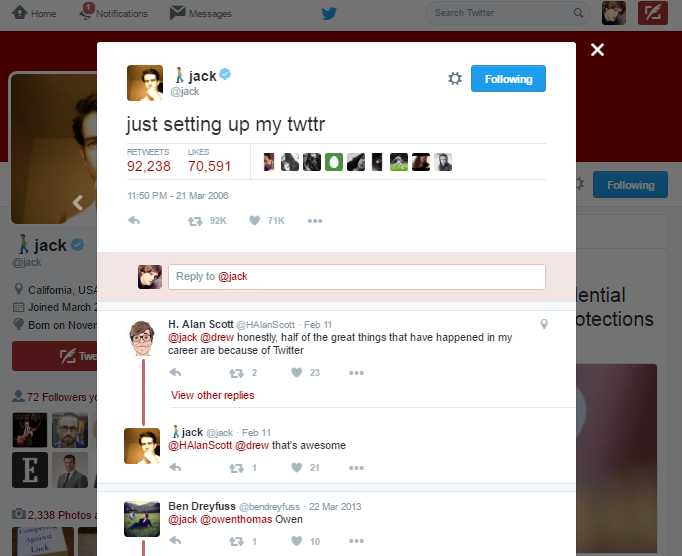
In 2010, a social network entered the scene, the feature of which is square photos similar to Polaroid photos and filters. Five years after launch, Instagram finally gave the opportunity to add photos and videos of any shape.
In 2012, Facebook bought Instagram for $ 300 million in cash and 23 million shares. The total amount amounted to one billion US dollars. The deal has surprised some people. But it turned out that Instagram is 49 times more expensive than Facebook paid for it.
Why did Instagram shoot ? Because photography is a universal language. Users don’t even need to read signatures, because photos processed with filters tell stories by themselves.
For the first day after the launch of Instagram in 2010, 25 thousand people registered in it. Given the fact that the network initially only worked on iOS. In 2012, Facebook head Mark Zuckerberg announced a 200 million registered user. In December 2014, Instagram outnumbered Twitter by the number of users. June 21, 2016 the number of users reached 500 million people.
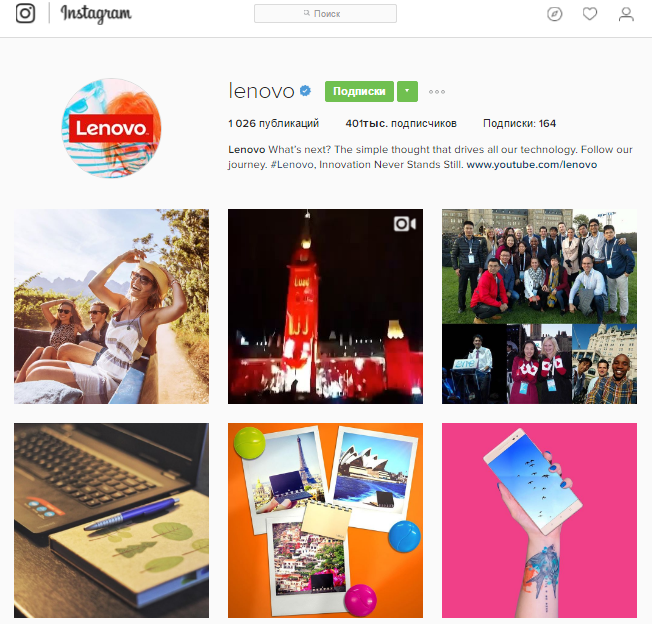
On social networks Vkontakte and Facebook, people tell stories and share thoughts. Moreover, the authors, that is, the creators of the original content, more on Facebook. In the Russian counterpart, users prefer reposts.
On Twitter, we no longer share stories, but short comments. Microblogging teaches laconicism, forcing them to pack their thoughts into a limited number of characters.
Instagram involves communication on a visual level. Sometimes it’s easier to take a photo or video instead of describing something in detail. Although you can share images on other networks, the narrow focus of content on Instagram guaranteed him success.
Users of each of these social networks communicate with each other. And advertisers, companies and agencies, earn money by targeting ads of relevant products to the desired target groups.
From the very beginning of the history of social networks, there are two ways to monetize them: advertising and paid subscriptions. The second option proved to be not the best side, so today it’s hard to find a paid registration - moreover, I will not name a single social network that would offer to pay for a personal account at this stage, therefore, if necessary, marketers can buy accounts in VC in bulk .
Targeted ads are actively used. The largest brands, small and medium-sized businesses - a huge number of companies have their own pages on social networks. This helps to communicate with the audience in their language and on those sites that are convenient for people. And they create advertising messages for them - both for a huge number of users at the federal level, and local messages - announcements of opening a new store, discounts on goods and services in a particular city or even on the right street.
There are a lot of opinions around social networks around audiences. Vkontakte - for schoolchildren, on Facebook - only professionals, Classmates - for senior citizens. These assumptions are justified, but only partially.
It is worth saying that the audiences of social networks are very overlapping - on average, 2.5diggers of a social network per person . And that the audience is constantly growing with networks.
Below are TNS research data. Pay attention to the share of users 25-34 years. In all social networks, it ranges from 26% to 35%, and mainly people of this age use the most popular social networks, not counting Vkontakte. Odnoklassniki has a higher proportion than the rest, the proportion of older people, and Vkontakte has a lot of users 18-24 years old.
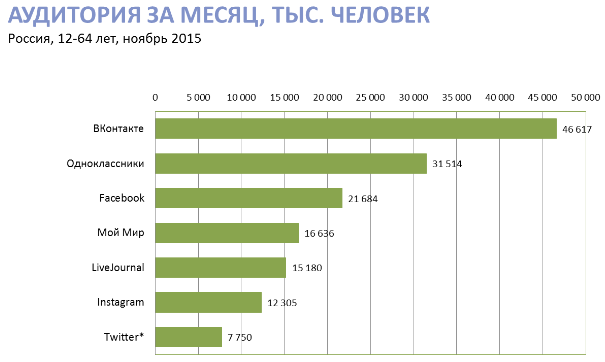
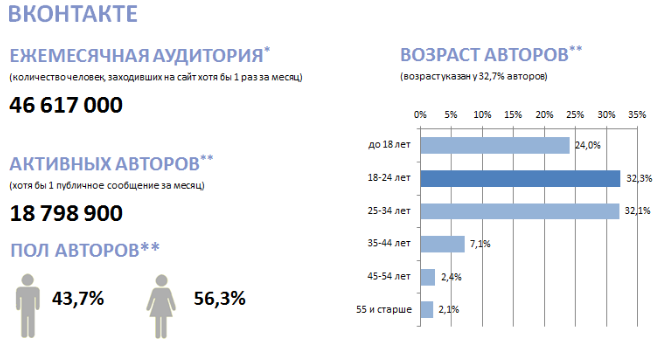
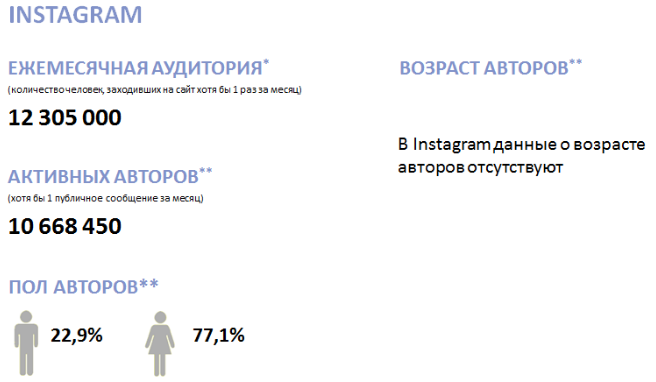
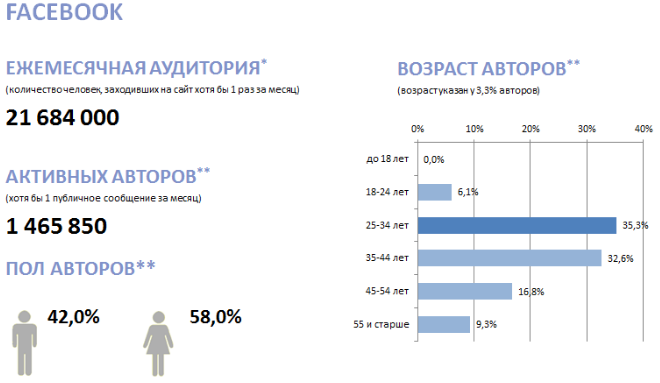
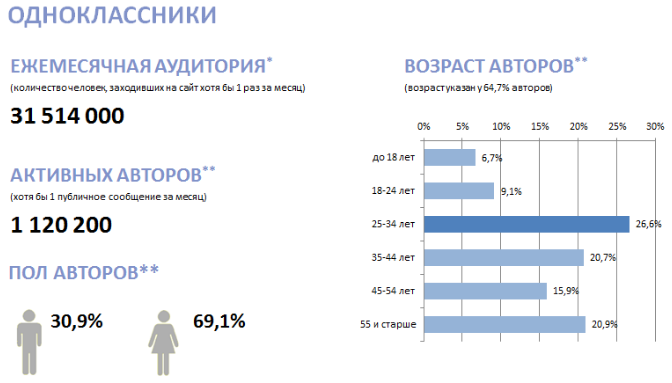
Why, in principle, go to social networks in order to promote your product? Because this channel allows you to reach a good share of the population. In Russia, the audience of 25-34 years of Vkontakte accounts for 72% of all residents of the country. At the age of 12-24, this figure reaches 84%.
Internal advertising tools allow you to target it by user’s geography, up to the city, by age and gender, interests, subscription to certain communities or recruitment - excluding group subscribers. Facebook and Vkontakte advertising offices have “pixels” that are embedded in your website: this allows you to then target ads to people who have visited the page.

Different ways to use social networks. If Vkontakte from desktops sit 24% of users, but on Facebook this figure is 53%. And vice versa - 48% of the audience use Vkontakte smartphones, and 30% use Facebook. Facebook, it is worth noting, has a problem with the application: it drains the battery heavily on Android.

Separately, there is video advertising. To attract more advertisers, you need to tell them about the huge number of views on the sites. Facebook used two tricks for this: automatic inclusion of the video while scrolling through the tape and overestimation of the time the video was viewed in its own reports . Mark Zuckerberg had to apologize for the second.
In order to effectively promote the topic that the advertiser needs, it is necessary to clearly understand which particular audience is the target. It’s not enough to say “men 18-45” - these are students eating boiled noodles in the hostel, and businessmen in cars for several million rubles. You need to understand the behavior of the target audience, their wealth, hobbies, marital status.
Let me give you an example from classical marketing - from the book “Neuromarketing in action. In time immemorial, one US airline tried to figure out how to sell airline tickets to businessmen. The survey found that men are afraid to fly not because of fear of heights, and not even because of fear of dying - but because of fear of leaving their wife and child without a breadwinner. As a result, the advertising campaign was aimed at women: do you want your husband to fly from a business trip faster? Want to spend more time together during your vacation? Fly on planes!
On the penetration of social networks, I gave a slide above that shows what percentage of the population of Russia of a certain age can be covered using a particular network. Some of the people who sit on social networks in the survey may answer that they do not use the Internet - for them, Odnoklassniki, for example, are not.
On the Internet, social networks are integrated into a huge number of sites. To enter the personal account of the office, which is responsible for the housing and communal services in my house, I use Vkontakte. News sites from social networks of the company are hanging on sites, authorization through networks is configured. The new Vkontakte tool allows you to put a button on the site to communicate with the company account in this social network - for convenient communication with the Customer Care service (customer care).
High network penetration is shown in real life. Communication takes place via Vkontakte messages instead of SMS. Although messengers come to the fore here - like instant messengers from social networks like Facebook Messenger and WhatsApp, as well as Telegram, Viber. In studies, most often show the rating of social networks and instant messengers on the same slides.
A striking example of the importance of social networks is the inheritance of accounts. In Delaware, it was legalized in 2014 . “You died” - such a phrase is issued from the threshold by lawyer Megan Ip to each client in her office in San Francisco, forcing an inventory of digital property. The audience not only grows up, but also dies, so in this case, Facebook and other resources have prepared an action plan for you .
The popularity of social networks contributes to the cheapening of smartphones. Today you can buy a decent thousand gadget for three rubles - it will definitely be enough to like photos on Instagram.
Consumers may not call the hotline, but instead write to the manufacturer or seller of Vkontakte. Customer Care will come and answer the question or file a complaint - unless, of course, the company cares about its customers.
Journalists in search of a hot topic and information on an already found issue are scouring social networks and various news stories in order to use some photos from the scene of an accident or other accident. They follow the accounts of managers of various companies in order to use sloppy statements against them and their employers, to raise a wave of indignation.
For sloppy statements can be fired, fined, imprisoned . And it’s easiest to say something wrong on a social network, especially when intoxicated.
A high penetration rate also puts people at risk. Skirmishes and fights due to tweets ceased to be something unusual. You can track the movement of many people by checking in on Swarm and Vkontakte. In 2011, the son of Eugene Kaspersky was kidnapped because the criminals had access to his home address on the Vkontakte page.
Social networks perfectly complement our lives. They help people communicate, companies help them sell products, and researchers help them identify behavioral trends based on messages. The main thing to remember is that this is not a “virtual” reality, but rather a part of real life: you will have to answer for your actions and words. But this is another story for a future article.
Social networks have become the most important tools at the moment, allowing people to talk to each other, share thoughts, images, videos, broadcasts, and advertisers to make targeted advertising for the target groups they need.
Today we’ll talk about how social networks evolved over the course of our history from 1995 to the present day, why and how it is beneficial for companies to use social networks, and how Vkontakte and Instagram have grown into the lives of ordinary people.

 The emergence of social networks was a matter of time. It was predicted back in the 19th century, when scientists were only trying to invent a working telegraph. Vladimir Odoevsky in the novel "4338 year" described a cross between LiveJournal and Instagram. In his world of the future, correspondence is being maintained between the houses with the help of newspapers. The senior butler, writing down the words from the words hozing at home, photographs it on a pinhole camera and publishes it in the required number of copies. Usually they report home news, various thoughts, invite them to dinner. For faster communication, for emergency cases, there are magnetic telegraphs between the houses.
The emergence of social networks was a matter of time. It was predicted back in the 19th century, when scientists were only trying to invent a working telegraph. Vladimir Odoevsky in the novel "4338 year" described a cross between LiveJournal and Instagram. In his world of the future, correspondence is being maintained between the houses with the help of newspapers. The senior butler, writing down the words from the words hozing at home, photographs it on a pinhole camera and publishes it in the required number of copies. Usually they report home news, various thoughts, invite them to dinner. For faster communication, for emergency cases, there are magnetic telegraphs between the houses. The author wrote his futuristic work in 1835, when the Russian diplomat and historian Paul Schilling had already assembled an electromagnetic telegraph in St. Petersburg, and Morse had not yet patentedhis version of the telegraph and did not receive a subsidy for the construction of the first line.
The fantasy of man is limitless. Thomas Edison in 1878 described the Telephonoscope, which can transmit images and sound so that relatives who are far apart can communicate. Like Vkontakte or Periscope. But even though fantasy moves forward, it works within the limits of available technologies - they thought then by telegraph, photographs and handwritten texts.
In the 1920s, the idea was implemented in Bell's telephone laboratory: then the research department tested a prototype that transmits audio and video from Washington to the AT&T New York office.
But smartphones in pockets at that moment were not even dreamed of.

Illustration for Thomas Edison's Idea

A one-way videophone developed at Bell Lab
on October 29, 1969, was the first to establish a connection between computers at the universities of Los Angeles and Stanford. In 1971, they developed a program for sending emails between computers. The ARPANET network in 1973 became international - it was connected to a transatlantic telephone cable. It allowed the exchange of information between scientific organizations in Europe and the USA. In 1984, scientists created the NSFNet network, which combined many university networks.
The advent of the Internet has opened up new opportunities for quick communication. First for the military, then for scientists, and then for the general public. In 1989, Tim Berners-Lee from CERN proposed the concept of the World Wide Web, developed the HTTP protocol. In 1991, private homes were finally connected to the Internet, not just educational institutions and military structures.
Since 1995, you can begin the history of precisely social networks. The Classmates.com portal, which still exists, was a pioneer. It allows you to find classmates, fellow soldiers, classmates from kindergarten, work colleagues. Over time, developers launched versions of the site with the same design and functionality for other countries.
In 2008, the portal Classmates.comtotaled fifty million subscribers. Of these, 3.8 million paid for membership.
Thanks to a lot of love for email newsletters ( just like Linkedin ), the portal has become a defendant in several legal proceedings. For example, in 2008, he paid users $ 9.5 million.

In 2002, the previously mentioned LinkedIn, a social network for business contacts, entered the scene. Here you could find a colleague in work or in a field of activity, tell about your work successes. In fact, a profile is a ready-made resume. The network allows you to monitor companies that periodically place vacancies.
Microsoft bought this social network in the summer of 2016 for $ 26.2 billion - it gave a little less than a third of its own cash.
The price is due to the fact that the network is actively developing and making a profit. LinkedIn has over two million paid subscribers that you can contact directly. In total, the community has 433 million members.

In 2003, the MySpace blogging platform appeared. This site was originally intended for young people who want to read, listen to music, share video content, post their photos and blog. In June 2012, attendance amounted to 25 million people.
For several years, MySpace has been the most popular social network in the world. But in 2008, that changed when Facebook recorded 129 million unique users and MySpace 114.6 million users.

Thefacebook website openedFebruary 4, 2004 and was available only to students at Harvard University. For twelve years, the social network has lost the article and reached 1.71 billion active visitors per month. Mark Zuckerberg became the youngest billionaire of the planet at 23 thanks to his invention.
Initially, the network was intended for students at Harvard University. In 2004, the audience was expanded to Stanford, Columbia University and Yale. In September 2006, the network became open to all users over the age of thirteen.
Facebook allows users to create their own page with photos and information, chat with friends, leave messages on the walls, upload videos and create groups, as well as company pages. Facebook as a tool for influencing the audience is used by many large corporations and local organizations. Actively use this social network businessmen and politicians for reputation purposes.
In April 2016, Facebook Live was launched on the social network - that is, its own Periscope.

Facebook design in 2004

Mark Zuckerberg's Facebook page in 2006
A similar story with the social network Vkontakte, the most popular in Russia. October 10, 2006 Pavel Durov launched this site as a network for students and graduates.
According to the data on October 2016 in a social network come daily over 80 million users. Of these, 65% are from Russia.

Vkontakte: the beginning

Vkontakte design in 2007
Albert Popkov launched Odnoklassniki on March 26, 2005. Prior to this, Popkov already participated in the creation of similar projects in Europe. In just eight months, the number of registered users reached one and a half million people, in 2007 this figure rose to four million.
In 2008, by analogy with Classmates, a paid subscription was introduced, only this time - not for additional functions, but at the registration stage. The site’s popularity has fallen, users overflowed VKontakte, and in 2010 they canceled paid registration. For 2010, 56% of network users are people aged 25-44.
In 2016, the function of money transfers and streaming broadcasts appeared on the social network, the company released the “OK video” application for Smart TV and integrated with Instagram.

In 2006, Twitter was launched. It was an SMS service for communicating with a small group of people. The question “What are you doing now?” Was central from the start. First tweetappeared on March 21, 2006, Jack Dorsey left him: "just setting up my twttr." Messages on Twitter several years ago could be published from ordinary phones - by sending text to the desired number for posting.
Initially, the number of characters was limited to 140. To fit the link, began to use abbreviations. In 2016, concessions were made - and the service stopped considering links in the restriction .
The whole point of Twitter is to put thought, idea, information for your friends into these 140 characters. Brevity is the soul of wit.

In 2010, a social network entered the scene, the feature of which is square photos similar to Polaroid photos and filters. Five years after launch, Instagram finally gave the opportunity to add photos and videos of any shape.
In 2012, Facebook bought Instagram for $ 300 million in cash and 23 million shares. The total amount amounted to one billion US dollars. The deal has surprised some people. But it turned out that Instagram is 49 times more expensive than Facebook paid for it.
Why did Instagram shoot ? Because photography is a universal language. Users don’t even need to read signatures, because photos processed with filters tell stories by themselves.
For the first day after the launch of Instagram in 2010, 25 thousand people registered in it. Given the fact that the network initially only worked on iOS. In 2012, Facebook head Mark Zuckerberg announced a 200 million registered user. In December 2014, Instagram outnumbered Twitter by the number of users. June 21, 2016 the number of users reached 500 million people.

On social networks Vkontakte and Facebook, people tell stories and share thoughts. Moreover, the authors, that is, the creators of the original content, more on Facebook. In the Russian counterpart, users prefer reposts.
On Twitter, we no longer share stories, but short comments. Microblogging teaches laconicism, forcing them to pack their thoughts into a limited number of characters.
Instagram involves communication on a visual level. Sometimes it’s easier to take a photo or video instead of describing something in detail. Although you can share images on other networks, the narrow focus of content on Instagram guaranteed him success.
Users of each of these social networks communicate with each other. And advertisers, companies and agencies, earn money by targeting ads of relevant products to the desired target groups.
Social Media for Marketing
From the very beginning of the history of social networks, there are two ways to monetize them: advertising and paid subscriptions. The second option proved to be not the best side, so today it’s hard to find a paid registration - moreover, I will not name a single social network that would offer to pay for a personal account at this stage, therefore, if necessary, marketers can buy accounts in VC in bulk .
Targeted ads are actively used. The largest brands, small and medium-sized businesses - a huge number of companies have their own pages on social networks. This helps to communicate with the audience in their language and on those sites that are convenient for people. And they create advertising messages for them - both for a huge number of users at the federal level, and local messages - announcements of opening a new store, discounts on goods and services in a particular city or even on the right street.
There are a lot of opinions around social networks around audiences. Vkontakte - for schoolchildren, on Facebook - only professionals, Classmates - for senior citizens. These assumptions are justified, but only partially.
It is worth saying that the audiences of social networks are very overlapping - on average, 2.5
Below are TNS research data. Pay attention to the share of users 25-34 years. In all social networks, it ranges from 26% to 35%, and mainly people of this age use the most popular social networks, not counting Vkontakte. Odnoklassniki has a higher proportion than the rest, the proportion of older people, and Vkontakte has a lot of users 18-24 years old.





Why, in principle, go to social networks in order to promote your product? Because this channel allows you to reach a good share of the population. In Russia, the audience of 25-34 years of Vkontakte accounts for 72% of all residents of the country. At the age of 12-24, this figure reaches 84%.
Internal advertising tools allow you to target it by user’s geography, up to the city, by age and gender, interests, subscription to certain communities or recruitment - excluding group subscribers. Facebook and Vkontakte advertising offices have “pixels” that are embedded in your website: this allows you to then target ads to people who have visited the page.

Different ways to use social networks. If Vkontakte from desktops sit 24% of users, but on Facebook this figure is 53%. And vice versa - 48% of the audience use Vkontakte smartphones, and 30% use Facebook. Facebook, it is worth noting, has a problem with the application: it drains the battery heavily on Android.

Separately, there is video advertising. To attract more advertisers, you need to tell them about the huge number of views on the sites. Facebook used two tricks for this: automatic inclusion of the video while scrolling through the tape and overestimation of the time the video was viewed in its own reports . Mark Zuckerberg had to apologize for the second.
In order to effectively promote the topic that the advertiser needs, it is necessary to clearly understand which particular audience is the target. It’s not enough to say “men 18-45” - these are students eating boiled noodles in the hostel, and businessmen in cars for several million rubles. You need to understand the behavior of the target audience, their wealth, hobbies, marital status.
Let me give you an example from classical marketing - from the book “Neuromarketing in action. In time immemorial, one US airline tried to figure out how to sell airline tickets to businessmen. The survey found that men are afraid to fly not because of fear of heights, and not even because of fear of dying - but because of fear of leaving their wife and child without a breadwinner. As a result, the advertising campaign was aimed at women: do you want your husband to fly from a business trip faster? Want to spend more time together during your vacation? Fly on planes!
Penetration
On the penetration of social networks, I gave a slide above that shows what percentage of the population of Russia of a certain age can be covered using a particular network. Some of the people who sit on social networks in the survey may answer that they do not use the Internet - for them, Odnoklassniki, for example, are not.
On the Internet, social networks are integrated into a huge number of sites. To enter the personal account of the office, which is responsible for the housing and communal services in my house, I use Vkontakte. News sites from social networks of the company are hanging on sites, authorization through networks is configured. The new Vkontakte tool allows you to put a button on the site to communicate with the company account in this social network - for convenient communication with the Customer Care service (customer care).
High network penetration is shown in real life. Communication takes place via Vkontakte messages instead of SMS. Although messengers come to the fore here - like instant messengers from social networks like Facebook Messenger and WhatsApp, as well as Telegram, Viber. In studies, most often show the rating of social networks and instant messengers on the same slides.
A striking example of the importance of social networks is the inheritance of accounts. In Delaware, it was legalized in 2014 . “You died” - such a phrase is issued from the threshold by lawyer Megan Ip to each client in her office in San Francisco, forcing an inventory of digital property. The audience not only grows up, but also dies, so in this case, Facebook and other resources have prepared an action plan for you .
The popularity of social networks contributes to the cheapening of smartphones. Today you can buy a decent thousand gadget for three rubles - it will definitely be enough to like photos on Instagram.
Consumers may not call the hotline, but instead write to the manufacturer or seller of Vkontakte. Customer Care will come and answer the question or file a complaint - unless, of course, the company cares about its customers.
Journalists in search of a hot topic and information on an already found issue are scouring social networks and various news stories in order to use some photos from the scene of an accident or other accident. They follow the accounts of managers of various companies in order to use sloppy statements against them and their employers, to raise a wave of indignation.
For sloppy statements can be fired, fined, imprisoned . And it’s easiest to say something wrong on a social network, especially when intoxicated.
A high penetration rate also puts people at risk. Skirmishes and fights due to tweets ceased to be something unusual. You can track the movement of many people by checking in on Swarm and Vkontakte. In 2011, the son of Eugene Kaspersky was kidnapped because the criminals had access to his home address on the Vkontakte page.
Social networks perfectly complement our lives. They help people communicate, companies help them sell products, and researchers help them identify behavioral trends based on messages. The main thing to remember is that this is not a “virtual” reality, but rather a part of real life: you will have to answer for your actions and words. But this is another story for a future article.
Only registered users can participate in the survey. Please come in.
What social networks do you use?
- 59.5% Vkontakte 196
- 31% Facebook 102
- 4.8% Classmates 16
- 17% Twitter 56
- 1.2% My world 4
- 17.9% Instagram 59
- 31.6% Don't use anything 104
